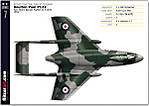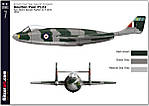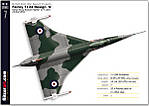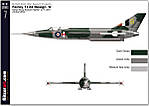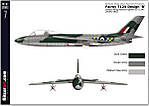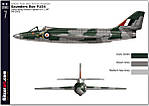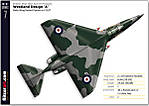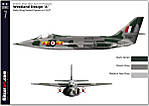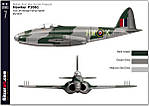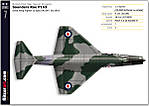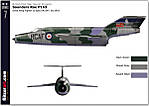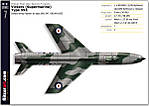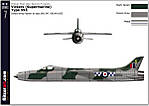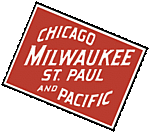1⁄35British Post War Secret Projects Vol. 3
7
Comments
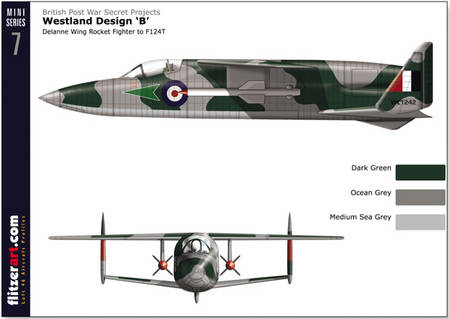
In this set I have focused one part on some of the many rocket powered designs and the others a variety of post war concepts.
Armstrong Whitworth and De Havilland starting rocket motor designs in 1946, producing the “Snarler” and the “Sprite” respectively. Further developments and saw both manufacturers produce more powerful designs, AW, the “Screamer” and DH the “Spectre. These two later motors were the proposed power plants for all the concepts to F124T spec, except Saunders Roe who proposed to design and build their own rocket engine. I’ve done some of these concepts from many designs, which I hope to include in future sets.
Boulton Paul P122. This design uses a twin boom layout with swept wings. The twin boom seems to have been popular with Boulton Paul as they produced quite a number of designs both during the war and post war with this configuration. Not much data has survived or is available for the P122.
Fairey 124T Design ‘A’. Fairey produced two designs.
The first was the ‘A’ scheme, dated 23/04/1952, featuring a cranked delta wing. It was to use the AW “Screamer” motor plus six booster rockets wrapped around the rear lower fuselage for take-off assistance. The design incorporated a conventional retractable tricycle undercarriage. Armament was to be a multi rocket pack or a pair of wing tip mounted Blue Jay missiles.
Fairey 124T Design ‘B’. The second design, scheme ‘B’, dated 23/04/1952, differed in featuring a swept wing and tail. The ‘B’ was to use the DH “Spectre” motor. This design was to do away with a conventional undercarriage, using a take-off trolley and landing skid instead, similar to the method the Germans used with the Messerschmitt Me163. Armament was as for the ‘A’ scheme; a multi rocket pack or a pair of Blue Jay missiles pylon mounted under the wings.
Saunders Roe P154. Saro produced this design with a delta wing with independently operating airlerons and a swept tail layout. A conventional undercarriage was included but take-off options included the use of a take-off trolley. For this project the company proposed designing and producing their own 8,000 lb thrust rocket motor.
Westland Design ‘A’. Westland produced two designs.
The first, the ‘A’ scheme, dated 23/04/1952, proposed a high mounted delta wing and 2 DH Spectre rocket motors mounted one on each side of the rear fuselage. It also included a conventional tricycle undercarriage. Provision was made for a pair of Blue Jay missiles mounted under the wings close to the fuselage sides.
Westland Design ‘B’. The second ‘B’ scheme was very different opting for a “Delanne” (twin monoplane) wing arrangement and a pair of DH Spectres this time stacked one on top of the other. As for design ‘A’ provision was made for a pair of Blue Jay missiles mounted under the wings close to the fuselage sides and included a conventional tricycle undercarriage.
A pair of designs submitted to spec ER.134T This spec called for designs to explore the possibilities of a very high speed; Mach 2 and beyond. Many manufacturers tendered designs, here are just two of them. More in future sets.
Saunders Roe P163. Saro’s design featured a shoulder mounted clipped delta wing and a whole moving tail. The design was the only one that proposed mixed propulsion, one jet and one rocket engine.The P163 was to be as simple and practical as possible, with easy manufacturing in mind.
Vickers Supermarine Type 553. The company considered many wing types and layouts before settling for the shoulder swept wing with the tail low below the main wings’ chord line.
For much more information about these and many other secret project aircraft I recommend Tony Buttler’s books.
That’s it for now...
Rocket Power
At the end of WW2 most of the German research and operational data became available to the Allies. The British were most enthusiastic in pursuing the development and advancement of the rocket motor as a viable means of propulsion. The potential benefits of up to 80,000 ft ceiling and an improvement of 80% acceleration and climb rate were too good to ignore. To this end the Air Ministry first issued specification OR.131. for designs for rocket motors followed by specification F124T for a rocket powered fighter.Armstrong Whitworth and De Havilland starting rocket motor designs in 1946, producing the “Snarler” and the “Sprite” respectively. Further developments and saw both manufacturers produce more powerful designs, AW, the “Screamer” and DH the “Spectre. These two later motors were the proposed power plants for all the concepts to F124T spec, except Saunders Roe who proposed to design and build their own rocket engine. I’ve done some of these concepts from many designs, which I hope to include in future sets.
Boulton Paul P122. This design uses a twin boom layout with swept wings. The twin boom seems to have been popular with Boulton Paul as they produced quite a number of designs both during the war and post war with this configuration. Not much data has survived or is available for the P122.
Fairey 124T Design ‘A’. Fairey produced two designs.
The first was the ‘A’ scheme, dated 23/04/1952, featuring a cranked delta wing. It was to use the AW “Screamer” motor plus six booster rockets wrapped around the rear lower fuselage for take-off assistance. The design incorporated a conventional retractable tricycle undercarriage. Armament was to be a multi rocket pack or a pair of wing tip mounted Blue Jay missiles.
Fairey 124T Design ‘B’. The second design, scheme ‘B’, dated 23/04/1952, differed in featuring a swept wing and tail. The ‘B’ was to use the DH “Spectre” motor. This design was to do away with a conventional undercarriage, using a take-off trolley and landing skid instead, similar to the method the Germans used with the Messerschmitt Me163. Armament was as for the ‘A’ scheme; a multi rocket pack or a pair of Blue Jay missiles pylon mounted under the wings.
Saunders Roe P154. Saro produced this design with a delta wing with independently operating airlerons and a swept tail layout. A conventional undercarriage was included but take-off options included the use of a take-off trolley. For this project the company proposed designing and producing their own 8,000 lb thrust rocket motor.
Westland Design ‘A’. Westland produced two designs.
The first, the ‘A’ scheme, dated 23/04/1952, proposed a high mounted delta wing and 2 DH Spectre rocket motors mounted one on each side of the rear fuselage. It also included a conventional tricycle undercarriage. Provision was made for a pair of Blue Jay missiles mounted under the wings close to the fuselage sides.
Westland Design ‘B’. The second ‘B’ scheme was very different opting for a “Delanne” (twin monoplane) wing arrangement and a pair of DH Spectres this time stacked one on top of the other. As for design ‘A’ provision was made for a pair of Blue Jay missiles mounted under the wings close to the fuselage sides and included a conventional tricycle undercarriage.
The Others
Hawker P1061. A straight wing development of the earlier P1054 design, with a 20 inch radar dish housed between the re-shaped nose intakes. Its hard to see where the proposed 4.5 inch gun would be positioned as the barrel would exit in the same place as the radar.A pair of designs submitted to spec ER.134T This spec called for designs to explore the possibilities of a very high speed; Mach 2 and beyond. Many manufacturers tendered designs, here are just two of them. More in future sets.
Saunders Roe P163. Saro’s design featured a shoulder mounted clipped delta wing and a whole moving tail. The design was the only one that proposed mixed propulsion, one jet and one rocket engine.The P163 was to be as simple and practical as possible, with easy manufacturing in mind.
Vickers Supermarine Type 553. The company considered many wing types and layouts before settling for the shoulder swept wing with the tail low below the main wings’ chord line.
For much more information about these and many other secret project aircraft I recommend Tony Buttler’s books.
That’s it for now...
Comments
Great thanks go to Merlin for publishing Vol 3.
In spite of a very heavy work schedule he still found the time to make it happen.
Cheers
Peter
:-)
FEB 09, 2007 - 04:18 PM
Great job. Really interesting reading and viewing.
I especially like the P1061. It is ungly in a very special way. Would love to see that one as a kit.
Thanks for sharing
FEB 10, 2007 - 12:01 AM
Excellent work as always Peter.
I cant help thinking that the Vickers Supermarine 553 looks like the MiG 21 Fishbed. Is this just coincidence or is there an interesting story here ?
Dave
FEB 11, 2007 - 06:00 PM
Sorry for the delay in replying...
Hi and many thanks for your comments.
Dave...
you are right the Type 553 does sort of look MiG-esque.
Whether or not there was some info leak we'll never know...
Many thanks again
Peter
:-)
FEB 17, 2007 - 11:37 AM
Hopefully with Pro Resin doing some Boulton & Avro prototypes we might see some of these coming out.
We can all dream.
Brian
FEB 24, 2007 - 03:47 AM
Copyright ©2021 by Peter Allen. Images also by copyright holder unless otherwise noted. The views and opinions expressed herein are solely the views and opinions of the authors and/or contributors to this Web site and do not necessarily represent the views and/or opinions of AeroScale, KitMaker Network, or Silver Star Enterrpises. Images also by copyright holder unless otherwise noted. Opinions expressed are those of the author(s) and not necessarily those of AeroScale. All rights reserved. Originally published on: 2007-02-09 00:00:00. Unique Reads: 17997




